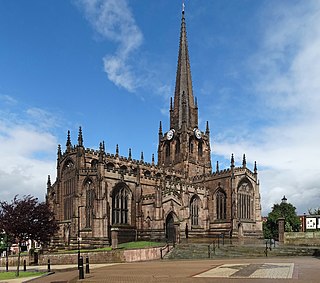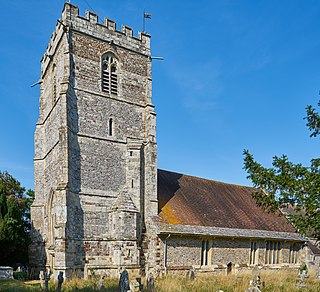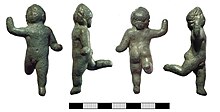
The Cathedral Church of the Holy Trinity,Saint Peter, Saint Paul and Saint Swithun, commonly known as Winchester Cathedral, is the cathedral of the city of Winchester, England, and is among the largest of its kind in Northern Europe. The cathedral is the seat of the Bishop of Winchester and is the mother church for the ancient Diocese of Winchester. It is run by a dean and chapter, under the Dean of Winchester.

South Warnborough is a small village and civil parish in the English county of Hampshire. In the 2001 census, the population was 407. In the 2016 census, the population was estimated to be 509.

St James' Church is in the village of Audlem in south Cheshire, England. It is recorded in the National Heritage List for England as a designated Grade I listed building.

Appleton is a village in the civil parish of Appleton-with-Eaton, about 4 miles (6.4 km) northwest of Abingdon. Appleton was part of Berkshire until the 1974 boundary changes transferred it to Oxfordshire. The 2011 Census recorded Appleton-with-Eaton's parish population as 915.

The Minster Church of All Saints or Rotherham Minster is the Anglican minster church of Rotherham, South Yorkshire, England. The Minster is a prominent example of Perpendicular Gothic architecture and various architectural historians have rated it highly. Nikolaus Pevsner describes it as "one of the largest and stateliest churches in Yorkshire", Simon Jenkins states it is "the best work in the county", and Alec Clifton-Taylor calls it the "glory of Rotherham". With its tall spire, it is Rotherham's most predominant landmark, and amongst the tallest churches in Yorkshire.

The Church of St Mary Magdalene is the Church of England parish church for the village of Ditcheat, Somerset, England. There has been a church on the site since 824, and the present building owes much of its grandeur to the Abbots of Glastonbury. Historic England have designated it a Grade I listed building.

The Church of St Peter and St Paul is the Church of England parish church for the village of South Petherton, Somerset, England. The present church is a large and imposing cruciform-shaped structure constructed on the site of an earlier Saxon Minster, with the majority of the building dating from the 13th to 15th centuries; consequently, the building is Grade I listed.

The Parish Church of Saint Mary, North Leigh is the Church of England parish church of North Leigh, a village about 3 miles (5 km) northeast of Witney in Oxfordshire.

Saint Mary's Church, is the civic church for the city of Southampton, Hampshire, England. Originally founded in circa 634, St Mary's has been the mother church of Southampton since its inception. The present building, now the sixth incarnation of a church on this site, dates mostly to a rebuilding from 1954 to 1956, following its destruction in the Southampton Blitz, except for the notable Grade II listed tower and spire, which date from 1912 to 1914.

St. Michael the Archangel Church is the oldest building still in use in the city of Southampton, England, having been founded in 1070, and is the only church still active of the five originally in the medieval walled town. The church is a Grade I Listed building.

The Parish Church of the Annunciation to the Blessed Virgin Mary is the Church of England parish church of Souldern, a village in Oxfordshire about 7 miles (11 km) northwest of Bicester and a similar distance southeast of Banbury.

Cranborne Priory is a former priory church in the village of Cranborne, Dorset, England. Founded in 980 as Cranborne Abbey, it became a priory in 1102, remaining that way until it was dissolved in 1540. The tower, nave and aisles from the priory survive to form the Church of St Mary and St Bartholomew, the parish church of Cranborne. The building, which has fragments from the 12th century, is designated a Grade I listed building.

The Church of St James the Less, Sulgrave, is the Church of England parish church of Sulgrave, a village and civil parish about 5 miles (8 km) north of Brackley, Northamptonshire. The present church dates largely from the 13th and 14th centuries and is recorded in the National Heritage List for England as a designated Grade II* listed building.

All Saints, Frindsbury, is a parish church serving the combined parish of Frindsbury with Upnor and Chattenden. The church dates from 1075 and lies in the north-west corner of the Medway Towns, historically part of Kent, England. It is a Grade II* listed building, National Heritage List number 1107886.

St Mary's Church is the main Church of England parish church for the areas of Portsea and Fratton, both located in the city of Portsmouth, Hampshire. Standing on the oldest church site on Portsea Island, the present building, amongst the largest parish churches in the country, has been described as the "finest Victorian building in Hampshire". It is at least the third church on the site and has been designated a Grade II* listed building by Historic England. Former regular worshippers here have included Charles Dickens, Isambard Kingdom Brunel, and Cosmo Lang.

St Catherine of Siena Church is an Anglican parish church in Cocking, a village in the district of Chichester, one of seven local government districts in the English county of West Sussex.

The Church of St Mary the Virgin is a parish church of the Church of England in Baldock in Hertfordshire. Dedicated to the Virgin Mary, the original church on the site dated to about 1150 and was built by the Knights Templar before being largely rebuilt in about 1330 by the Knights Hospitaller. It is a Grade I listed building.

All Saints Church is an Anglican parish church in the village of Crondall, Hampshire, England. It is a Grade I listed building and stands at the highest point in the village. Much of the church dates from the Norman period, although the original central tower was replaced by a brick one at the north-east corner in 1659 and some alterations, particularly to the fenestration, the nave arcades and transepts, and the north porch, were made in two stages during the 19th century.

St Peter's church is the Church of England parish church for the village of Ash in Surrey. Of 12th-century origin with later additions, the church has been Grade II* listed on the Register of Historic England since 1967. It is part of Aldershot Deanery in the Diocese of Guildford.

The Church of St Laurence is the main Church of England parish church for the village of Downton, Wiltshire, England. An unusually long building for a village church, the present structure dates from 1147. Continually altered and enlarged until the mid-19th century, the church displays every style of architecture from the Norman to Victorian eras, and has been designated a Grade I listed building.
























